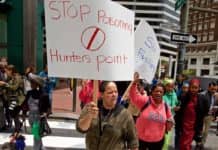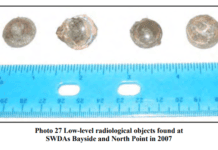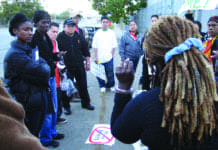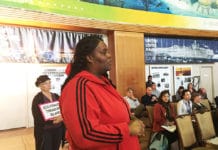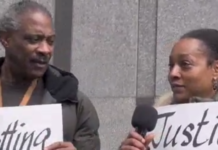
by Ahimsa Porter Sumchai, M.D.
At the conclusion of Part I, Dr. Sumchai wrote: “Parcel A of the Hunters Point Shipyard was a ‘dirty transfer’ of property from the federal government to the City and County of San Francisco in 2004. Only two sites on Parcel A were carried through to the Remedial Investigation stage of the federal Superfund or CERCLA act.
“Parcel A never underwent a full cleanup to the final remedy stage as required by CERCLA and was transferred with a litany of residual contaminants from lead and asbestos in buildings to arsenic, metals, motor oil and breakdown products of diesel in soil and groundwater.”
How dirty was the ‘dirty transfer’ of Parcel A
The declaration statement of the Record of Decision (ROD) for Parcel A of the Hunters Point Shipyard published pursuant to the CERCLA Act on Nov. 16, 1995, states, “Based on an evaluation of analytical data and other information, the Navy has determined that no remedial action is necessary to ensure the protection of human health and the environment at Parcel A.”
The Parcel A ROD documents the soil analysis conducted by the Navy for metals at one of the two Parcel A Remedial Investigation (RI) sites. Numerous metals remained in concentrations exceeding their preliminary remediation goals as established by the EPA after the Navy had excavated the soil. Arsenic was detected in 40 of 41 samples, beryllium in 36 of 41 samples, chromium in 19 of 41 samples, manganese in 35 of 41 samples, as was nickel.
Parcel A was transferred with deed restrictions notifying the public of lead-based paint contamination in buildings. The lead-based paint survey was conducted in 1997. According to the Parcel A Finding of Suitability to Transfer (FOST), when the 1997 supplemental lead sampling was complete, lead in concentrations exceeding the 221mg/kg EPA cleanup goal was detected on Parcel A.
Rather than clean it up, the BRAC Cleanup Team reviewed all of the data on lead for Parcel A from both the 1993 and the 1997 sampling. The average concentration of lead in soils across Parcel A derived from the 1993 and 1997 sampling was calculated to be 215 mg/kg. Because it fell short of the 221 mg/kg cleanup goal, it was allowed to remain in the soil.
Over the next decade, Parcel A buildings were allowed to deteriorate without soil testing at the time of the transfer of the property in 2004. Thus, the Navy could not guarantee that lead-based paint had not been released into Parcel A soils exceeding the 221mg/kg cleanup requirement at the time of the Parcel A transfer 10 years later.
The Parcel A FOST identifies the presence of lead-based paint in buildings on Parcel A and prohibits use of these structures prior to demolition. The city was charged with responsibility for managing all lead-based paint hazards, including soil contamination, in compliance with the Residential Lead Based Paint Hazard Reduction Act of 1992.
Parcel A buildings with lead-based paint are being leased by the Redevelopment Agency to artists and other base tenants despite the risk of lead exposure.
Under Article 31, Health Dept. both polices and gets paid by Lennar
On Nov. 16, 2004, the city’s Health Commission endorsed Article 31, a new environmental ordinance establishing for Parcel A residual soil concentrations and requirements for preparing plans and reports, including site evaluation and mitigation, risk evaluation and closure reports. Article 31 was voted into law by the Board of Supervisors in December of 2004 and signed by the mayor in 2005.
It mandates that health and safety plans address the hazards of each phase of construction site operations at the Shipyard and include requirements and procedures for employee protection, including health and safety risk or hazard analysis and medical surveillance. Article 31 also establishes residual soil screening criteria for Parcel A. Hazardous constituents listed include inorganic and bioaccumulative toxic substances, volatile organic pollutants, PCBs, total petroleum hydrocarbons, pesticides, metals and radionuclides.
Article 31 gives the director of the San Francisco Department of Public Health the authority to bill the developer fees to defray the cost of document processing and review, consultation and administration of Article 31. For fiscal year 2007-2008, that fee is $153 per hour. Section 3109 of Article 31 cites as violations “fraud, willful misrepresentation, or any willfully inaccurate or false statement in any report required by this article.”
Article 31 confers upon the Health Commission the power to enforce developer compliance with deed restrictions, EIR mitigation measures and other city, state and federal laws. Enforcement mechanisms include withholding or denial of permits, work stoppages, penalties for permit violations and mandatory civil penalties.
Despite the documentation of an exposed symptomatic population of workers and children at the Parcel A site, Health Director Mitchell Katz and Director of Occupational and Environmental Health Rajiv Bhatia have failed to devise human exposure protocols for toxic dust exposure and failed to order standard of care tests for a population symptomatic of pneumoconiosis – the deposition of dust particles in the human lung, including baseline chest X-rays, pulmonary function tests, lead and arsenic testing.
Indeed, the City has taken the public stance that no harm has resulted from the particle pollution exposures, according to statements made by the Health Department, the Mayor’s Office and appointed members of the Mayor’s Citizens Advisory Committee for the Shipyard.
The EPA has released pamphlets and fact sheets on particle pollution identifying people with heart or lung disease, older adults and children to be at greater risk from particles, especially when they are physically active. Short-term exposures to particles within hours or days can aggravate lung disease, causing asthma attacks and acute bronchitis, and may also increase susceptibility to respiratory infections.
In people with heart disease, short-term exposures have been linked to heart attacks and arrhythmias. Long-term exposures have been associated with reduced lung function, the development of chronic bronchitis and premature death.
Children are at increased risk because their lungs are still developing, they spend more time at high activity levels, and they are more likely to have asthma or acute respiratory diseases when particle levels are high.

Gary McIntyre is the former Parcel A project manager who filed suit, along with two other African-American high ranking employees this year, against Lennar Corp. in Superior Court in a case scheduled to go forward in early 2008. He testifies that asbestos levels at Parcel A sensed by Lennar’s air stations reached an astounding 58,000 structures per cubic meter in December of 2006. Additionally, McIntyre states he was diagnosed and treated by medical doctors for respiratory symptoms and that he and the other plaintiffs were held to a code of silence about the asbestos exceedances.
A stadium atop a Superfund site?
Mayor Newsom recently proposed the dirty transfer of the remaining 430 land-based acres of the shipyard – a federal Superfund site – to the City and County of San Francisco to meet the 49ers 2012 deadline for construction of a new stadium. He proposes that a “specialized environmental remediation firm be allowed to finish certain elements of the cleanup” with the City providing “extensive oversight.”
The Shipyard’s level of toxic contamination has not been fully characterized. It would be a liability to accelerate the transfer of a federal Superfund site from the National Priority List with the data gaps that exist in the characterization of this property. The city admits it cannot clean up the Shipyard’s radiation-contaminated sites, which comprise the bulk of Parcels D and E. Parcel F, the Shipyard’s underwater region, has not been adequately studied.
If the rest of the Shipyard is transferred out of federal control and becomes the property of Lennar BVHP, a limited liability, private, non-governmental corporation, government oversight will become as dangerously secretive as it is now on Parcel A.
Lennar of Miami, one of the nation’s largest home builders, is “bleeding” from profit losses that stem, in part, from a litany of lawsuits it has accrued, including three filed in San Francisco in the last year. It is currently being sued for faulty home construction in San Francisco’s South Beach community.
In 2006, an appliance deliveryman was electrocuted in a bizarre accident in Lennar’s Lost Lake Reserve in Clermont, Florida. A wrongful death lawsuit was filed when the deliveryman was electrocuted even though the power to the room had been turned off. An investigation revealed that faulty wiring created a giant power surge that electrified the house and killed the serviceman as he connected a dryer hose to a vent.
The Arizona Republic’s six month investigation in 2001 found that Lennar was forced to buy back parts of entire neighborhoods after lawsuits over problem homes. Lennar was accused of fraud and negligence in three suits involving 44 West Valley homeowners who claimed their homes have cracks in the driveways, stucco, foundations and interior walls because the homes were built on land with expansive soils.
The Holderby family, owners of a Hampshire Home in a Miami suburb built by Lennar, found a gigantic hole in their backyard filled with murky brown water and construction debris. Venomous snakes, insects and amphibians emerged from the opening in the soils in the yard, which was, in fact, on top of a dump for garbage, tires and construction debris.
In 1998, Lennar escaped a class-action fraud suit through a technicality in the village of Doral Sands, Miami, where the builder constructed homes on land that had been filled with debris and trash.
The Wall Street Journal reported on Feb. 12, 2003, that Lennar was granted the right to destroy fragile plants and animal dwellings on 174,000 acres in Riverside, California.
And on Sept. 19, 2003, the Phoenix office of the U.S. Equal Employment Opportunity Commission announced the filing of a lawsuit against Lennar Homes of Arizona alleging discrimination by over 40 employees.
What should we do with the Shipyard? The Shipyard should be cleaned to residential standards per the Community Acceptance mandate of the federal Superfund Act encoded in San Francisco’s November 2000 voter mandate Proposition P. The Shipyard should be developed under a Bayview Hunters Point Beneficiaries Economic Empowerment plan that establishes a Resident Stock Ownership Corp. that is 100 percent owned and controlled by its shareholders, the residents and small businesses of BVHP.
Transferring the Shipyard away from its designated beneficiaries will cause them irreparable economic, political and physical harm. This is a violation of trust law and the transfer of taxpayer owned, public assets to a private corporation.
Contact Bay View Health and Environmental Science Editor Dr. Ahimsa Porter Sumchai at (415) 835-4763 or asumchai@sfbayviewnews.wpenginepowered.com.

 Store
Store





